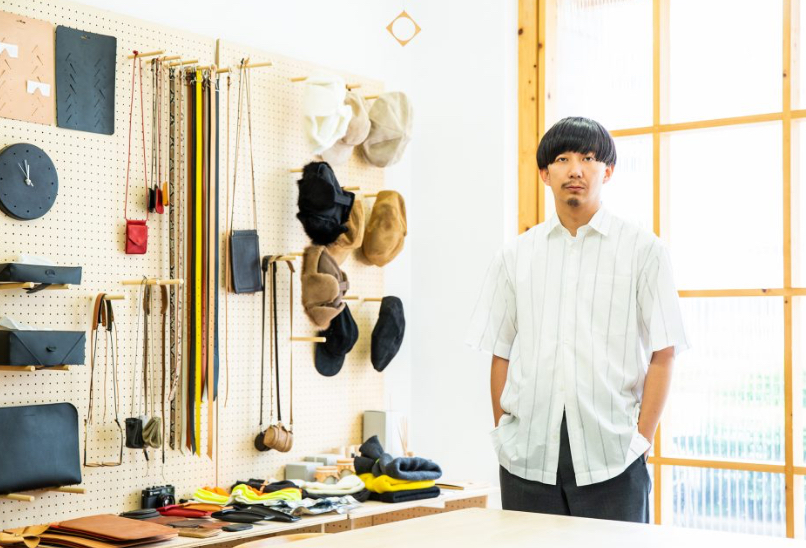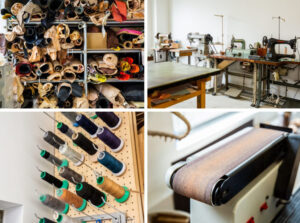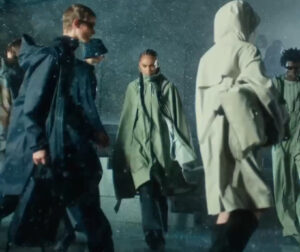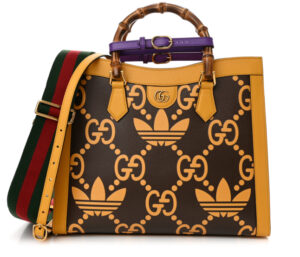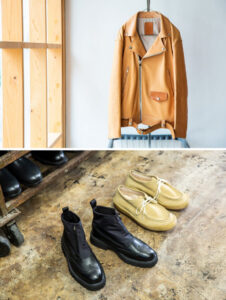
A Study in Leather, Time, and the Art of Ambiguous Design
In a Tokyo backstreet thick with the aroma of street broth and cigarette ash, a faint hum resonates from behind a matte orange PVC curtain. It is not music. It is not commerce. It is the slow, metronomic rhythm of craft—a sound nearly extinct in fashion’s hyperspeed present. Inside this unmarked space, among hand-worn hammers and CNC routers, Ryo Kashiwazaki and his team give shape to a paradox. Hender Scheme is not a label. It is a philosophy.
Founded in 2011 by Kashiwazaki—once an apprentice cobbler in Asakusa, now a leading voice in post-craft theory—Hender Scheme produces leather objects that transcend utility. They are products, yes. But they are also questions: What does it mean to own something? When does a material begin to speak for itself? Can design live outside the tyranny of theme?
Hender Scheme does not answer these questions outright. It lets you wear them. Watch them wrinkle. Let them absorb time.
The MIP Series: Deconstructing Iconography
When the Manual Industrial Products line launched, it was dismissed by some as luxury parody—leather versions of classic Nike, Adidas, and New Balance sneakers, stripped of logos and dipped in natural vegetable-tanned leather. But for Kashiwazaki, this wasn’t mimicry. It was metaphysics.
He began the project in secret during his years repairing mass-produced footwear. The idea was simple: what if an object stripped of branding and synthetic material could retain—perhaps even deepen—its essence?
The first prototype, a leather Air Force 1, sparked interest in artisan circles. The second—a reinterpretation of the Adidas Superstar—ignited the fashion underground. The MIP-01, crafted entirely from raw cowhide, required:
- 270 hours of air-drying, to retain geometric fidelity
- 12 layers of edge-paint, applied with a single-hair brush
- Cork midsole and leather outsole, stitched—not glued
- Hand-numbering, not for exclusivity, but accountability
These weren’t shoes. They were skeletal studies, exposing the anatomy of industrial iconography.
Kashiwazaki once said, “We don’t parody—we perform an autopsy.” In this way, the MIP series redefined luxury as a space not for excess, but for inquiry.
The Leather Paradox: Warmth vs. Severity
Leather, for Hender Scheme, is not just a material. It is a memory machine. Every fold, every creased toe box, every oil-darkened corner is a timestamp. But what makes their work remarkable is not nostalgia—it is restraint.
Consider their nubuck Ivy jacket. Cut in the image of 1960s Harvard blazers, its silhouette is familiar. But its surface tells another story:
- Japanese steer hide, soaked in persimmon tannins
- Brushed to mimic suede, then electrostatically sealed
- Lined with raw silk dyed in sumi ink
It is simultaneously archival and alien. Soft and armored. Kashiwazaki explains, “Leather remembers. But we guide what it forgets.”
This is the central paradox: the brand takes something ancient, then tempers it with space-age detailing. Saddle stitching is done beside laser skiving. Oxidation is induced with enzymes. The result? Objects that seem neither old nor new—just inevitably present.
Spatial Philosophy: The Kappabashi Flagship
Step into Hender Scheme’s flagship and you enter a showroom that behaves like a temple crossed with a repair station.
- The threshold? An orange PVC curtain, borrowed from restaurant kitchens.
- The centerpiece? A street-visible cobbler bench, where artisans stitch while pedestrians watch.
- The signage? None.
There is no cash register, only a wall-mounted iPad. No scent diffusers, only the mingling notes of beeswax and brass. Customers are invited to sand edges, stamp initials, and discuss wear cycles.
One section, “gap services”, offers:
- Free conditioning after one year
- Complimentary cork insert replacement after two
- Custom lacing with customer-chosen thread counts
On one shelf sits a miscut derby shoe. Its heel is off-center, the stitching uneven. A plaque reads: “Our First Attempt. Keep the flaw.”
Here, imperfection is not hidden. It is honored.
Time as Form: Designing in the Age of Speed
In an era where fashion is reduced to 15-second TikToks and seasonal fatigue, Hender Scheme embraces slowness as rebellion.
There are no collections. No fashion shows. Instead, the design rhythm is:
- Seven-year product arcs
- Living prototypes, worn by staff for 18 months before release
- No “themes”, because as Kashiwazaki puts it, “Themes are traps. We prefer terrain.”
Their AW19 boot exemplifies this ethos. Inspired by mountaineering gear from the 1970s, it features:
- Aerospace-grade titanium speed hooks
- Inverted grain leather (the inside becomes the exterior)
- A Vibram Cristy sole with hand-grooved ridges
It doesn’t scream trend. It murmurs longevity.
V. Cultural Reception: Between Reverence and Riddle
Hender Scheme resists fashion industry conventions, yet its cultural footprint grows by the year. Why?
Because it refuses to pander.
- Products are priced between ¥55,000 and ¥380,000
- Weekly production caps at 23 pieces
- Clients include chefs, architects, choreographers—not hypebeasts
Collectors say the shoes feel like sculpture. Writers compare the wallets to origami. Academics teach the brand as material philosophy.
At the Royal College of Art, MIP-12 is used in the curriculum for Post-Form Design. At the Vitra Museum, a leather brogue sits beside Dieter Rams’ record player.
Its popularity, ironically, stems from its refusal to speak loudly. As one Keio University professor put it: “Hender Scheme sells the silence other brands fear.”
Future Forms: The Art of What’s Next
What lies ahead for a brand that refuses forecast?
In 2025, Hender Scheme is building:
- A Leather Library: housing 100+ hides with RFID-linked origin stories
- Bio-tanned copper hardware, oxidized with sea enzymes instead of chemicals
- An unbranded horological object, designed with a Swiss watchmaker and released anonymously
Each project continues the brand’s commitment to ambiguity, longevity, and material storytelling.
Kashiwazaki remains unhurried. “In 50 years, I don’t want someone to say ‘this was designed in 2025.’ I want them to say, ‘this always existed.’”
Epilogue: The Enduring Gap
At twilight, back in the workshop, an artisan wipes down a last and lays it in a cedar box. A shopper finishes engraving initials into a cardholder. No music plays. Only the sound of thread being pulled through leather, of beeswax being warmed by hand.
This is the sound of the gap.
Between speed and stillness. Between use and ornament. Between the known and the undefined.
Hender Scheme does not fill this gap.
It lives inside it.
And in doing so, it offers a new blueprint for design—not as style, not as solution—but as presence.
Appendix: Materials & Metrics
- Leather Sources:
- 5 tanneries in Japan
- 3 in Germany
- 1 in Scotland
- Stitch Density:
- 7.2 stitches per centimeter (vs luxury industry standard of 5.5)
- Employee Retention:
- 92% since founding
- Average Object Lifecycle:
- 8–12 years before first major repair, with patina integral to function
Visiting Notes
Hender Scheme – Kappabashi Flagship
1-5-2 Matsugaya, Taito-ku, Tokyo
No social media. No e-commerce.
Just the scent of leather and the echo of time.
No comments yet.

